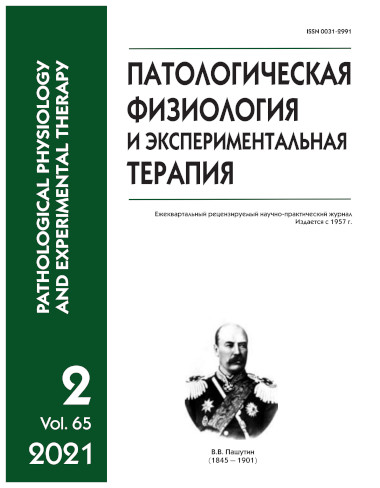Alphaсalcidol modulation of the dexamethazone effects on parameters of M-response of skeletal muscle of white rats
Abstract
The aim of this research was to evaluate the effectiveness of pharmacological doses of alfacalcidol (ALF, 0.06 μg/kg/day) in compensating the negative effects of chronic dexamethasone treatment (DM, 0.25 mg/kg/2 days, for 30 and 60 days) on parameters of the M-response of mixed type skeletal muscle with a predominance of glycolytic fibers (m. tibial anterior). Methods. The experiments were performed on sexually mature female rats (195-205 g) initially divided into four groups: 1) control group (n=10, C-group); 2) first experimental group (n=20, treated with dexamethasone, DM-group); 3) second experimental group (n=20, treated with dexamethasone in combination with alfacalcidol, DM+ALF-group); 4) third experimental group (n=20, treated with alfacalcidol, ALF-group). The drugs were administered in doses equivalent to the human therapeutic dose for 30 and 60 days: 1) dexamethasone (KRKA, Slovenia) 0.25 mg/kg once every 2 days, i.p; 2) alfacalcidol (Alpha D3-Teva, Catalent Germany Eberbach GmbH, Germany) 0.06 μg/kg daily, p.o. Each experimental group was divided into two subgroups of 10 each, depending on the number of treatment days: 30DM- and 60DM-subgroups; 30DM+ALF- and 60DM+ALF-subgroups; 30ALF- and 60ALFsubgroups. Electromyography experiments were conducted on rats anesthetized with sodium thiopental (100 mg/kg). Parameters of the M-response of the tibialis anterior muscle were studied during suprathreshold electrical stimulation of the fibular nerve. Results. ALF in combination with DM prevented the lengthening of the latent period of the M-response and a decrease in its amplitude, as was typical for the 30DM-subgroup. ALF in combination with DM also increased the amplitude of M-responses compared to the control (p<0.05) and by 85 and 60% in the 30DM+ALF- and 60DM+ALF-subgroups, respectively. The duration of the latent period of M-response in the 30DM+ALF-group increased by 60%, and there was a tendency to preserve the lengthening of M-response in the 60DM+ALF-subgroup. The prevalence of polyphasic M-responses in the 30DM+ALF-subgroup (50%) was comparable to that of the 30DM-subgroup (40%), while in the 60DM+ALF-subgroup, it was lower than that of the 60DMsubgroup (20% vs 40%). Increases in the amplitude and duration of M-responses in the 30DM+ALF-group with the appearance of polyphasic potentials in 50% of the rats may indicate myogenic damage of the neuromuscular apparatus, including collateral sprouting of muscle fibers partially cleaved by necrotic foci. These increases may also indicate neurogenic genesis of disorders associated with long-term glucocorticoid therapy. The frequency of polyphasic M-responses after fatigable work (FW) in animals of the DM-groups partly decreased relative to the initial value, whereas in rats of the DM+ALF-groups, polyphasic M-responses after FW were absent. This fact indicates different causes of the polyphasicity of M-responses in the DM- and DM+ALF-subgroups. The main cause of polyphasicity in the DM-groups was the failure of normal muscle fibers in motor units (MU) to generate a fullfledged M-response, whereas the main cause of polyphasicity in DM+ALF-subgroups was a decrease in the degree of excitement synchronization in pathologically altered nerve or muscle fibers. ALF, when administered in combination with DM, prevented a decrease in muscle mass and the number of activated MUs, which was typical for DM-groups. However, there was still a tendency for a decrease in muscle mass when the pair of drugs was administered. After 30 days of the DM+ALF treatment, the nature of changes in the M-response parameters and the number of activated muscle MUs after FW was similar to that of the 30DM-subgroup in many respects. At the same time, after 60 days of the DM+ALF treatment, a less pronounced but significant decrease in the amplitude of M-responses after FW was noted in comparison with the control (p<0.05). This occurred in the presence of a more pronounced increase in the duration of M-responses, but at the same time was comparable with a decrease in the number of activated muscle MUs in the control group. These facts indirectly support an increase in muscle MU density and the ability of ALF to weaken the increased fatiguability caused by DM administration. At the same time, the lengthening of the latency period of muscle M-responses after FW was typical for the animals treated with DM regardless of ALF administration, which was not typical for control rats. This fact is evidence favoring greater synaptic fatiguability or possibly reduced reliability of synaptic transmission with DM administration regardless of ALF. Conclusion. The results of the model experiments provided indirect evidence that dystrophic changes in muscle fibers and increased muscle fatiguability produced by DM alone were reduced by ALF combined with DM. Thus, ALF can be recommended as a therapy to alleviate steroid myopathy during prolonged glucocorticoid therapy.






